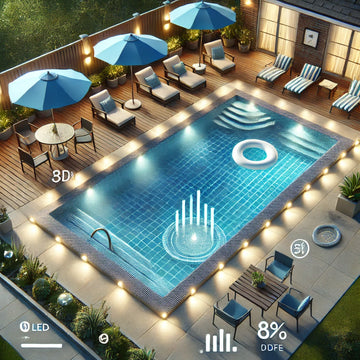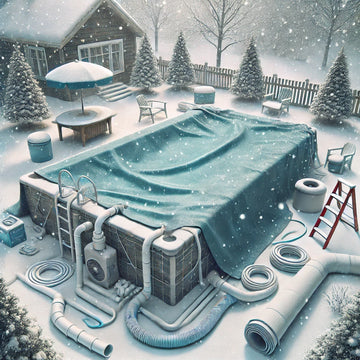Lifting the Lid on Post-Winter Pool Blues
Nothing says spring like the excitement of opening your pool after a long and cold winter to get it ready for summer. But oftentimes, this can reveal a host of problems like leaks, green and cloudy water, or other issues that need to be taken care of. The last thing you want to do is find these types of problems in spring when all you can think about is summer pool fun, let alone the expense of costly repairs.
In this article, we explore some of the more common issues that can present themselves and why they happen and go over some tips on how to resolve and prevent them.
The Impact Winter Has on Your Inground Pool
Winter can wreak havoc on your pool if proper measures aren’t put in place to take care of it. Freezing water expands and leads to ground frost, which can lead to burst or cracked filters, pumps, and valves. PH levels can also be affected, increasing the acidity in the water. As a result, leaving your pool as is throughout winter can mean headaches in the spring when it comes time to ready it for summer.
When to Open Your Pool After the Winter
The general rule of thumb when it comes to opening your pool, is that the temperature should consistently be above 21 degrees during the day or the ice is fully melted on the pool and there is no more chance of frost on the weather radar. While this may seem early, the main factors to consider are algae, mother nature, pollen, expenses, and beauty. Opening your pool when the temperature consistently reaches this level during the day helps to prevent algae from growing. It also helps keep pollen from collecting in the water and costs far less than opening later in the springtime.
Common Opening Problems and How to Resolve Them
When it comes to issues that pool owners face, there is a common theme. You may find yourself with burst or cracked equipment, such as filters, pumps, and valves. PH levels can be off, creating the green or cloudy water that we so often see. Below, we discuss some of the common issues that pool owners may encounter.
Water Leaks
The first thing to look at when opening your pool in spring is the water level. This is sometimes your only visual queue to indicate that you may have a problem. Leaking pools can become a disaster in cold climates, resulting in cracks in suction lines, saturated ground conditions, and liner tears. As a best practice, you should check your water level periodically in the winter months as well.
Air Leaks
Ah, the elusive air leak. This is a common occurrence when plumbing lines have bin damage in the winter and can be more dangerous than a water leak. Pumps can lose prime when air is sucked back into your system, putting extra stress on the pump when it is turned back on. This can lead to melted and/or warped components. An air leak can also damage plumbing and pump components leading to very costly repairs. However, also keep in mind that small air bubbles when the system is priming are normal and completely harmless.
Algae
Water that is out of balance, warmer temperatures, sunlight and the presence of nitrates, phosphates, and carbon dioxide can all cause algae in your pool. Lack of good circulation, filtration, and sanitation prior to closing is typically the primary cause of pool algae.
Cloudy Water
Cloudy water can be caused by many factors, such as chlorine levels, PH imbalances and alkalinity, high calcium levels, clogged filters, early stages of algae, ammonia and debris.
Green Water
Green water is caused by algae. This occurs when the chlorine levels drop below 1 ppm, making it necessary to shock the water with chemicals to kill the algae.
Stains
Surface stains in pools are common and are usually due to insufficient cleaning before closing. Ensuring that your pool is free of leaves and debris, over-filtering your water before closing and letting the pump run for a few days before you close the pool can help prevent this.
Damaged Pool Cover
When it comes to pool covers, there are many threats lurking, including ice, rain, snow, trees, and animals. If your pool cover becomes damaged, it can wreak havoc on your pool and cause future headaches. Inspect your pool cover regularly to ensure that damage does not go undetected.
How to Prevent Issues from Arising After Winter – The Importance of Proper Winterization
If you want to save yourself a lot of grief in the springtime, closing your pool properly at the end of the summer season is imperative to ensure a happy opening in spring. Getting your equipment organized, preparing your pool, filters, pumps and heater (if applicable), draining and blowing out your lines, plugging the skimmer hole, and balancing your chemicals are all necessary steps to ensure your pool is closed properly. Winter safety pool covers are also highly recommended.
Avoid Cutting Corners During Closing
Closing your pool is an essential part of every pool owner’s maintenance routine. With proper preparation and a solid closing process, your pool will be protected in winter and make spring far more enjoyable when it comes time to open it up and enjoy it once again.




